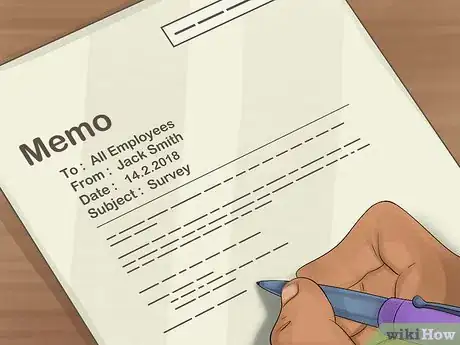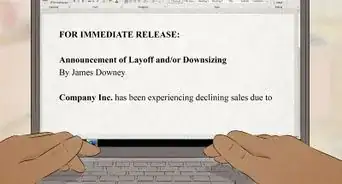This article was co-authored by Jeffrey Fermin. Jeffrey Fermin is a Performance Marketing Manager based in Miami, Florida, who currently works for AllVoices. He’s also the Founder of a full-service marketing company called New Theory. With over 10 years of experience, he specializes in digital marketing and content creation. He earned a Bachelor’s Degree in Psychology and a Bachelor of Education from Florida International University. Jeffrey has won a Microsoft Octas Innovation Award and is a TechCrunch Disrupt Runner-Up.
This article has been viewed 26,552 times.
Employee surveys are a great way to ask for feedback about employee satisfaction or how you can improve your company, but they only work if your employees complete them! Sending a memo or email with all the key information about the survey can help motivate them to fill out the survey. Creating paper-based surveys that can be submitted in semi-public areas can help your employees feel more anonymous, which increases the likelihood they'll turn their surveys in. We'll walk you through the steps to encourage your employees to respond to your survey!
Steps
Inviting Employees to Take the Survey
-
1Let your employees know the survey is coming. Send your employees a couple of emails in the weeks before you send out the survey. If they know it's coming, it will already be on their mind when it actually arrives. This can increase the likelihood they'll complete the survey.[1]
-
2Write a memo with key information about the survey. Once you're ready to send out the survey, include a memo with it. The memo should include all of the key information about the survey and why it's important.[2]
- Tell your employees what is happening and why. For example, you can say something as simple as "We are conducting an employee survey to gauge employee satisfaction after our business merger."
- Make sure you reassure your employees that the survey is confidential.
- Tell your employees how you'll use the results. For example, you can say "We'll use your responses to reorganize how you work with your supervisors."
- Give your employees a deadline and tell them where to turn in their surveys. Make sure you set up a confidential place for turning in their surveys. A common area is best, like a breakroom or near the time-clock.
Advertisement -
3Tell your employees how long it will take. If employees know up front how long the survey will take, they're more likely to schedule the time to complete it. If you don't give them any indication of how long they need to spend, they'll likely skip the survey.[3]
- Make sure you tell your employees that they can complete their surveys on company time. They'll be more likely to complete it if they know they can take some time to do it at work than if they have to take it home.
-
4Have the highest-ranked leader possible sign the memo. If the invitation to participate in the survey comes directly from a high-ranking leader, employees are more likely to feel listened to and therefore more likely to participate.[4]
Administering the Survey
-
1Give paper-based surveys. Computer-based surveys are easier to collect, but employees also know that there are ways to track their responses (even if you're not doing so). Allowing your employees to fill out paper-based surveys will make them feel that their answers are more likely to be anonymous.[5]
-
2Include the surveys with the invitation memo. If you include the survey (and a blank envelope for returning it) with the invitation memo, employees don't need to worry about asking for one or picking one up from somewhere everyone can see them. It increases their sense of anonymity and allows you to keep their answers confidential.[6]
-
3Set up an anonymous place for turning in the surveys. If you ask employees to give their completed surveys to someone within the company, they're less likely to turn them in. They might worry that the person collecting the surveys will look at their answers, or that they'll track which survey was theirs. Instead, set up a locked collection box where employees can drop completed surveys to ensure anonymity.
-
4Provide incentives for completing the survey. Group incentives for completing the surveys can help increase the response rate. For example, you could offer in-office lunch to the department with the highest response rate. If your company is small, rely on individual incentives.[7]
- Even just following up and thanking your employees for their time and feedback shows that you appreciate them filling out the survey.
Creating Your Survey
-
1Rely on scale questions. Scale questions present an opinion, fact, or situation and then ask respondents to rate how true or likely it is. Employees are more likely to respond to these types of questions, since they only have to fill in a bubble, than open-ended questions where they have to write out an answer.[8]
- For example, you can ask questions like "My supervisor resolves customer conflict quickly" and then offer scale answers. Give them 5 bubbles in a horizontal line, and place "Strongly disagree" above the bubble all the way to the left and "Strongly agree" above the bubble all the way to the right.
-
2Write a survey that takes less than 20 minutes. If your survey is too long, your employees are likely to give up halfway through and never turn it in. Try to make the survey as short and concise as you possibly can. The survey should only take about 20 minutes, which would mean 50 to 75 scale questions.[9]
-
3Phrase some questions negatively. If you ask too many questions that seem to suggest you're looking for a positive answer, employees might stop the survey. Phrasing about a third of your survey questions negatively can prevent this.[10]
- For example, instead of wording a question that says "We do a good job of resolving conflicts in my department," word it so it says "We do a poor job of resolving conflicts in my department."
-
4Place questions about demographics at the end of the survey. One of the most important factors in getting employees to answer surveys is anonymity. If you ask demographic questions up front, employees may feel it will reveal who they are, and they'll be less likely to answer the rest of the survey.[11]
- If you do have to ask demographic questions, limit how many you include. Three is the absolute most you should use.
References
- ↑ http://www.employeesurveys.com/helpful-information/how-to-obtain-a-high-response-rate/
- ↑ http://www.busreslab.com/index.php/articles-and-stories/esat-key-steps/inviting-the-employees-to-your-employee-satisfaction-survey/
- ↑ http://www.busreslab.com/index.php/articles-and-stories/esat-key-steps/inviting-the-employees-to-your-employee-satisfaction-survey/
- ↑ http://www.busreslab.com/index.php/articles-and-stories/esat-key-steps/inviting-the-employees-to-your-employee-satisfaction-survey/
- ↑ https://hbr.org/2002/02/getting-the-truth-into-workplace-surveys
- ↑ https://hbr.org/2002/02/getting-the-truth-into-workplace-surveys
- ↑ http://www.busreslab.com/index.php/articles-and-stories/esat-key-steps/inviting-the-employees-to-your-employee-satisfaction-survey/
- ↑ http://www.employeesurveys.com/helpful-information/how-to-obtain-a-high-response-rate/
- ↑ http://www.employeesurveys.com/helpful-information/how-to-obtain-a-high-response-rate/
About This Article
If you need to ask your employees to complete a survey, get them ready for it by sending them an email a couple of weeks ahead of time. Once you’re ready to send out the survey, include a memo with it that lays out all of the key information. For instance, tell your employees why you are conducting the survey and how the results will eventually be used. Make sure to reassure them that their answers are confidential. That way, more people are likely to complete the survey. You should also give your employees a deadline and a confidential place to turn in their responses, like the employee breakroom. For more help, like how to create a survey your employees are more likely to complete, read on!



































































